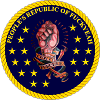1974: Second Shepistani-Dominion War
Prologue
The end of the first Shepistani-Dominion War was unsatisfactory for both sides, Shepistani, while bloodied badly, had not been crippled in it's war making potential by the Old Dominion. Likewise, Shepistan failed to secure any territorial gains(specifically a land corridor to East Shepistan) and returned to the prewar borders.
After the war there was a purge of the officer corps in the Shepistani Military, and a new emphasis was placed on initiative and training. The new leader, the former Minister of Hydroelectric Infrastructure somehow seized the reigns of party leadership and became known as The Great Shep.
By 1968 the rebellion in East Shepistan had grown significantly, galvanized by the inconclusive outcome of the war. More and more troops poured into the region, but in 1972 a battalion-sized battle was fought against the rebels in the salt marshes of East Shepistan.
In 1974 the East Shepistan Assembly declared independence(and took the name The Wheeling Republic). Shepistani forces were on the verge of being overwhelmed by the rebels, and so the Shepistani army was mobilized and rushed to transit points along the border. The Great Shep demanded transit rights to East Shepistan. The Old Dominion refused.
The military situation in 1974 was somewhat better for the Old Dominion than the last time around. 800 Chieftain MBTs had entered service, in addition to the 300 AMX-13s, 200 Centurions with 230 Super Shermans rounding out the force. FV430 series APCs and IFVs rounded out the force, with the M3 Halftracks relegated to motorized regiments(or prime movers for towed artillery).
In the air the fighter force for the ODAF had turned completely over to the F-4 Phantom II. As during the last war A-4s, A-7s, and Buccaneer S.2s made up the attack force, although the ODN was in the process fo acquiring A-6 Intruders.
 Centurion underway during a peacetime exercise.
Centurion underway during a peacetime exercise.
The ODN had an uneven improvement in capabilities. While the
Centurion had become fully modernized, the
Victory was unable to operate modern aircraft. It had already been decided that in the event of another war the
Victory would likely be relegated to convoy duty, due to the obsolescence of it's air wing. The ODN had entered the Joint MESS Common Carrier program, and design was far along, but the keel for the first CVN would not be laid down until 1977.
The Great Shep had pursued a vigorous modernization program for Shepistan.
Although 500 M48s remained, as well as 400 M60A1s, the real punch came from the 1000 T-72s that had entered service. In addition, 400 PT-76 amphibious tanks and 600 BMP-1s had been procured. They would be used to great effect in the crossing of the Potomac River.
Approx. 1200 Fighter jets made up the SAF, 800 MiG-21 in various conditions and variants, 65 F-105s, and 200 MiG-23s. 100 Su-24s had been added for a dedicated attack role.
The SN was as dilapidated as it had been during the previous conflict, with only 22 major surface combatants.
Still, the active Shepistan army was 1.8million men, while the active Dominion army was only 600,000, although another 100,000 MESS servicemen were in country.
The Great Shep decreed that significant amounts of troops would be pulled away from it's Western Borders and used in a broad-front attack on the Old Dominion. Crossing points were carefully registered by Shepistani artillery. The attack commenced April 1st.
The first days
The Old Dominion military had taken note of the rapid transit of forces to the borders, and so was putting the to field when the attack came. Fortunately, this meant that the Shepistani airstrikes failed on the first day, and the Shepistani advances had to move with contested airspace.
The Shepsitani 1st Army plowed through XII Corps at Rogers Pass, and drove it off our Wythe Ridge by the end of the first day. To the North the 409th Special Republican Guard Commando seized Richards Pass and facilitated the ejection of Dominion units deployed in defense of Lynchburg. At Hickman's Crossing 2 Shepistani Divisions routed a defending Division consisting of mixed MESS units. And, at Legion Point, the 19th Special Naval Infantry crossed the broad Potomac river in PT-76s and BMP-1s.
The 4 thrusts achieved their goal of overwhelming the defenders. At the end of the day none of the forces were less than 40 miles withing Old Dominion territory. Indeed, the 19th Special Naval Infantry was nearing Fairfax City, Ancestral Home to the Lord Fairfax.
On the second day the 3rd Naval Air Wing, flying out of East Shepistan, attacked the
Victory battle group which was transiting out of Norfolk. The Su-24s had trained over and over the past year specifically with the aim of sinking a Dominion aircraft carrier, and the antiquated Sea Vixens were unable to stop the attack. Of the 20 Su-24s involved in the attack, 3 were shot down by the escorts and 1 by the CAP. During the course of the attack an estimated 15 1,000lbs bombs were dropped on the
Victory. The Carrier quickly went down with all hands. A photo of the sinking carrier found it's way into the MESS Media.
On land the 1st Army continued South, by now the Dominion XII Corps had been joined by the 2nd Imperial House Cavalry, led by the Crown Prince Tung. The MESS forces were driving to the town of Leesburg, where they attempted to encircle a Shepistani armored brigade. In the ensuring battled the encirclement failed as the rest of 1st Army caught up, 200 tanks were destroyed total on both sides. MESS forces were forced South of Leesburg.
At Hickman's Crossing the Shepistani 9th Army broke out of the tenuous cordon and seized Ashburn. A Shinra battalion trapped in the city center surrendered
en masse.
At Fairfax City a hastily called up Territorial Brigade fought a tenacious defense against the Shepistani forces, but reinforcements arrived too late to prevent the Shepistani 2nd Army from taking the city. A Dominion Division arrived to the West in Burke, and dug in.
Everywhere the Shepistani forces advanced...except in East Shepistan. There, the Dominion VII Corps crushed the chronically undermanned 3rd Army at the Battle of Shepardstown. Dominion and MESS forces were augmented by rebel units as much of the country turned on the Shepistani Army.
On April 3rd the 1st and 9th Shepistani Armies linked up at Sterling, where XII Corps(and 2nd IHC) had been joined by IV Corps. In the Battle of Sterling, which lasted the next 4 days, 15,000 MESS servicemen gave their lives in one of the biggest debacles of the war, and began a headlong retreat towards Spotsslyvania.
The Static War
By now the Shepistani media was mentioning how the extensive mechanizing of the Dominion Army since the last war allowed it to retreat faster than ever! While the Shepistani advances at Burke and outside of Lynchburg had been checked, the combined 1st-9th advance brought them 150 miles into the country. And it was here that the effects of the officer purge began to show.
While the Shepistani General Staff had carefully planned out much of the early war prior, no plan existed for an advance this far into the country,
despite the need for a land corridor to East Shepistan. Quality of Shepistani attacks began to to take a precipitous downturn, and gradually the fighting became stalemated, as the arrival of MESS air wings wrested control of the skies from Shepistan. By late May the arrival of more MESS units(and the calling up of Territorial Army units) had allowed Dominion offenses to begin.
Counterattack
 MESS carriers steaming towards Shepistan.
MESS carriers steaming towards Shepistan.
The MESS naval task force began OPERATION: RED RUM June 3rd. The three carriers(HMS
Centurion, SRS
Hercules, Theseus) commenced round -the-clock airstrikes on targets near population centers in West Shepistan. An effective blockade was established, and much of the Shepistan navy was sunk at anchor. Warplanes were recalled from the front to defend the cities, thus ending any pretense of challenging MESS dominance of the air.
XII Corps, IV Corps, and 1st Coalition Army Group launched an attack to dislodge the Shepistani forces in Spotsslyvania. The Shepistani Army, running critically short on supplies due to uninterrupted bombing of convoys, withdrew towards the border. Over the next three weeks coalition forces pushed the Shepistanis back, and in early August sufficient forces had been found to drive them across the border(at the time Imperator Schimmer had began military operations in Asscrackistan, and The Great Shep had had to rush troops back to the Assrackistan border). On August 8th VII Corps drove the Shepistanis out of Fairfax City.
August 10th saw the start of OPERATION: ROUGH CHUCKLES, with IV Corps leading a breakthrough of Rogers Pass. 200,000 Coalition troops poured into Shepistan, and before they could move any deeper(clearing the wya for more troops) The Great Shep offered a ceasefire.
The Old Dominion immediately agreed. The actual border with Shepistan would remain the same, but Shepistan would recognize the independence of East Shepistan. Shepistan agreed, and The Wheeling Republic was created. Thus ended the last major war(although border skirmishes would continue to the present day) between Shepistan and the Old Dominion.
) but are great assets for the game due to their storytelling potential, like Shroom.
 "
"











